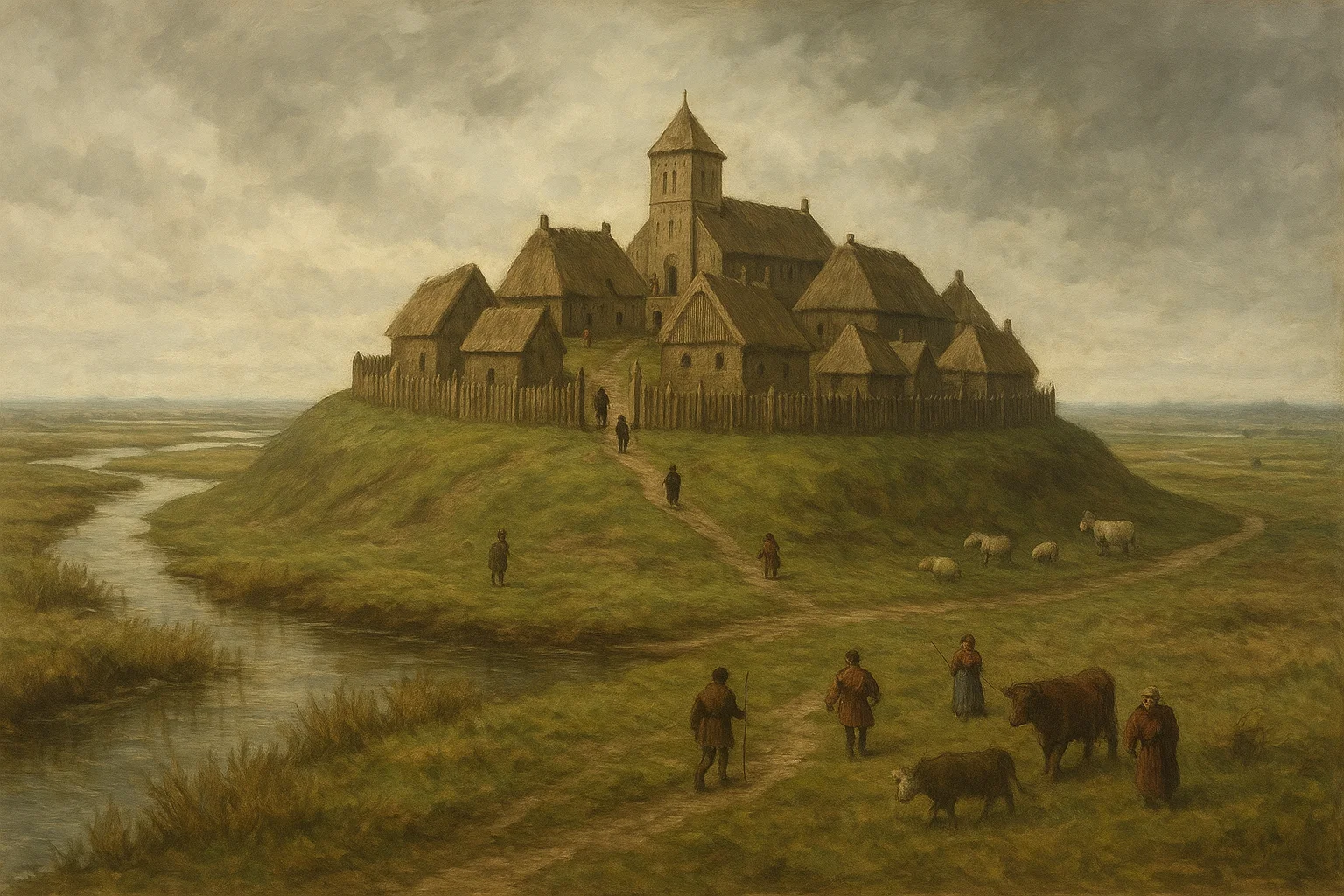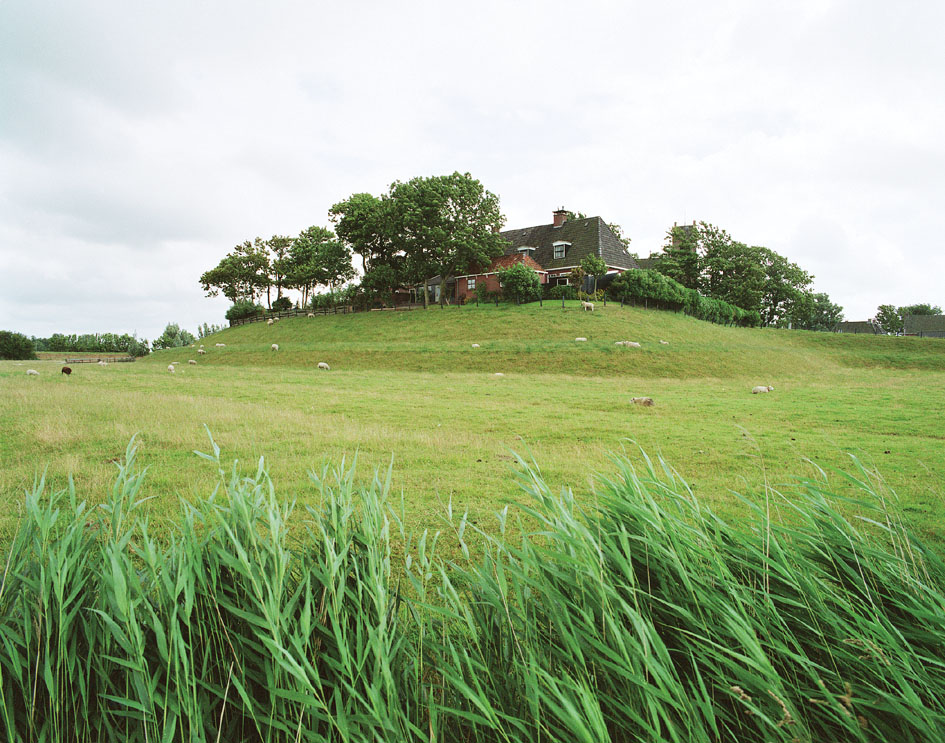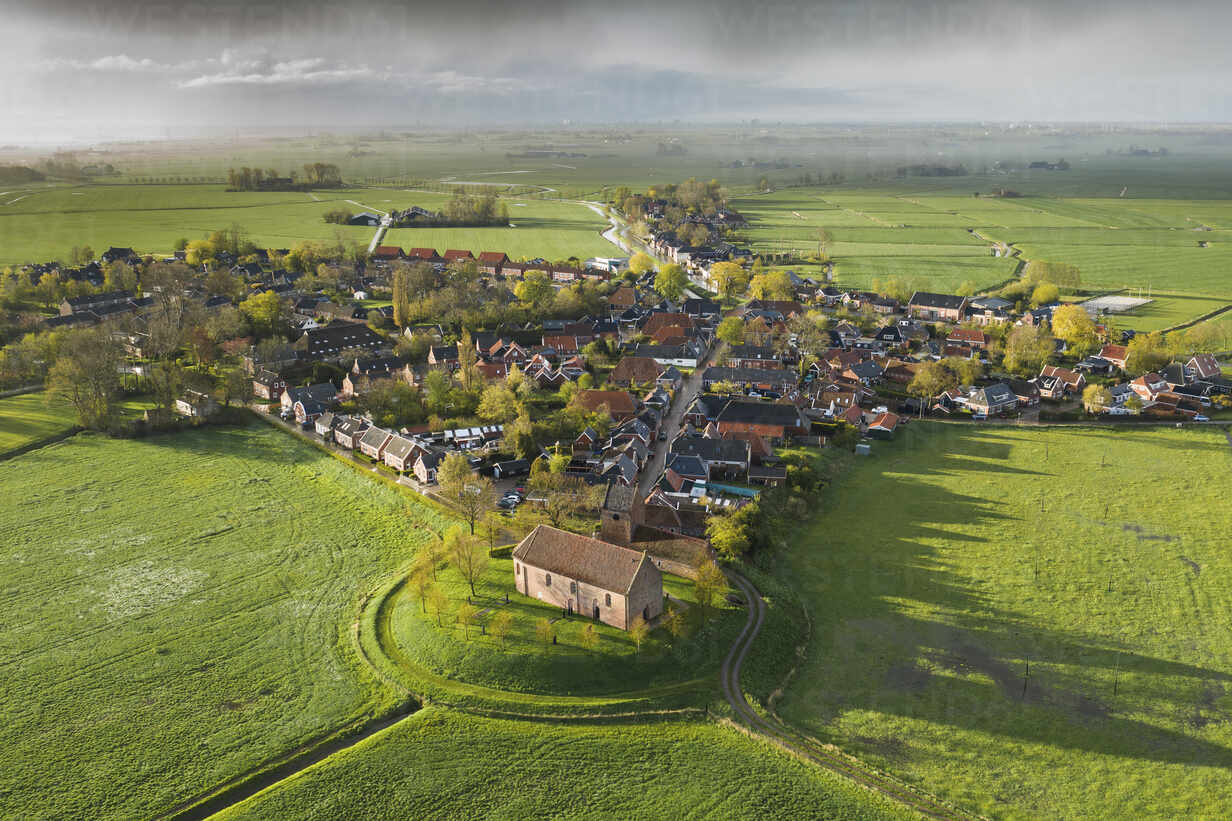Introduction
Terps – artificial dwelling mounds raised above flood-prone terrain – were a hallmark of ancient North Sea coastal communities. Built up by hand with layers of clay, sod, and manure, these mounds provided safe, dry ground for farms and villages amid the low-lying salt marshes of Frisia and adjacent regions.1 Thousands of these elevated settlement mounds (called <em>terpen</em> in Friesland, <em>wierden</em> in Groningen, and <em>wurten</em> or <em>warften</em> in German coastal lands) were constructed between roughly 600 BC and 1100 AD, before systematic dike systems reshaped the landscape.2
Terp sites form an archaeological record spanning from the Iron Age into the early medieval period, offering rich insights into how communities adapted to environmental challenges and rising sea levels. This article examines terps and equivalent raised settlement forms in the cultures of the North Sea coast, with a focus on their development and role during the Migration Period (4th–9th centuries AD).
Origins and Early Use (Iron Age and Roman Period)

Artistic reconstruction of an early medieval terp settlement showing a church, surrounding buildings, and grazing livestock. The elevated position of the settlement above the surrounding marshland provides protection from flooding while allowing access to fertile grazing lands.
The practice of building dwelling mounds in the coastal Low Countries dates back to the mid-Iron Age. As new salt-marsh lands formed along the North Sea (in what is now the northern Netherlands and northwestern Germany), people began settling them around the 6th–5th centuries BC.3 These flat marshes were fertile but prone to periodic inundation by the tides. To cope with flooding, early inhabitants raised their farmsteads on small artificial mounds – the first terps.4
Initially, a terp might be just large enough for a single farmhouse (house terp), but over time these mounds could be expanded and merged. As population grew, families would enlarge the terp or cluster multiple mounds together, eventually forming a larger village terp hosting several households.5 By around 200–100 BC, terp-dwelling communities were well established across the northern coastal zone.
Ancient writers took note of these curious elevated hamlets on the flooded fringes of the world. The Roman author Pliny the Elder in the 1st century AD gave a famously bleak description of the Frisian terp-dwellers, calling them "people who live on mounds of soil and are sailors at high tide, but shipwrecked at low tide," referring to how they clung to hillocks above the sea and scraped by as the waters rose and fell.6
While Pliny's account was disdainful, archaeological evidence suggests Iron Age terp communities were far from destitute. The fertile salt-marsh environment provided rich pasture for livestock and renewed soil for crops after each inundation: when exceptionally high tides flooded the marshes, a layer of fresh clay would be deposited, replenishing the fields with fertile silt.7 Terp farmers took advantage of this, raising cattle and sheep and growing grains and other crops on the surrounding lowlands.8
They built large timber longhouses – typically three-aisled houses with central living space and attached stables under one roof – on top of their mounds, ensuring both people and livestock stayed above the water during floods.9 What emerged, then, was a resilient agro-pastoral system uniquely adapted to the tidal marshland.
By the Roman period (1st–3rd centuries AD), terp villages dotted the coastal plains of Frisia and beyond. Excavations show that these communities were not isolated bog-dwellers but were plugged into wider exchange networks. Terp habitations have yielded imported Roman goods such as pottery, coins, and glass, indicating active trade between terp settlers and the Roman world (via intermediary markets).10
One monumental site, the Feddersen Wierde in modern Germany, illustrates the prosperity of a late Iron Age terp settlement. This mound, fully excavated in the 1950s, grew into a true village by the 2nd–3rd century AD: archaeologists found evidence of about 26 farmsteads (primarily timber longhouses) on the mound, housing an estimated 300 inhabitants with some 450 cattle – a substantial community sustained by marsh grazing and farming.11 To build and maintain such a settlement, the residents methodically raised the mound over generations, using mud, turf, and cattle dung to heighten the terp and keep it above the ever-threatening floods.12
Not all was static prosperity, however. Environmental evidence suggests that the late Roman period brought increasing challenges for terp communities. Around the 3rd century AD, a combination of rising sea levels (a marine transgression) and socio-economic upheavals (including the decline of Roman influence) led to partial depopulation of the northern coastal region.13,14
Many terp settlements were abandoned in the 3rd or early 4th century as encroaching water and waterlogged lands made life more difficult.15 For instance, the terp of Leeuwarden (Oldehoofsterkerkhof) in Friesland shows no occupation after about 300 AD,16 and several small terps in Groningen (e.g., Paddepoel) were given up and silted over by the late 3rd century.17
It appears that by the eve of the Migration Period, large swathes of the terp region had been vacated or saw greatly reduced population. Yet this was not a universal abandonment – a few strongholds like Ezinge, a major terp in Groningen, continued to be inhabited straight through the 4th and into the 5th century.18 Such sites may have served as refugia for the remaining coastal folk, preserving elements of the local culture even as others left. What happened next would set the stage for a new chapter in terp history, as migrating peoples entered or re-entered the landscape.
Terps in the Migration Period
The Migration Period (c. 4th–9th centuries AD) was an era of dynamic change in Northern Europe – marked by the movement of tribes, the rise of new kingdoms, and environmental flux. In the North Sea coastal lowlands, this period saw terp settlements either revived by newcomers or reoccupied by returning groups, giving rise to what we can call the early medieval terp culture.
Archaeological strata on some terps show a clear horizon around the 5th century: below that level, late Roman Iron Age material; above it, a suite of early medieval artifacts and building styles often linked to incoming Anglo-Saxon or Saxon settlers.19,20 This corresponds with the broader historical narrative that groups such as the Angles, Saxons, Jutes, and Frisians were on the move across the North Sea during the 5th century, with some migrating to Britain and others resettling the coastal mainland. The once-abandoned terp region did not lie empty for long.
Exactly who resettled the Frisian terps after the 4th-century lull has been debated. Earlier scholars like Boeles (writing in 1906) interpreted the sudden appearance of "Anglo-Saxon" style pottery and metalwork in 5th-century terp layers as evidence of an invasive Anglo-Saxon migration into Frisia.21 Indeed, at Ezinge, a distinct layer of ash and debris was noted above the Roman-era deposits, overlain by small buildings and sunken huts containing Anglo-Saxon pottery and brooch types – this was initially taken as proof of a violent takeover by Anglo-Saxon newcomers.22
Modern research has refined this view: the consensus now is that there was an influx of new people and material culture in the 5th century, but it likely involved a gradual immigration and integration rather than a single military conquest.23,24 Many of the settlers were culturally similar Germanic groups (Saxons, Angles, and allied Frisians) who moved in as opportunities opened. The coastal population had drastically declined by the mid-4th century,25 so these new settlers often occupied semi-deserted terps rather than displacing large indigenous communities.26,27 In essence, the Migration Period "reboots" habitation in the terp region with a strong Anglo-Saxon–Saxon cultural imprint overlaying residual Iron Age Frisian elements.
One striking example is the fate of Feddersen Wierde. This once-thriving terp village saw a decline in the 5th century and was completely abandoned by around 450 AD.28 According to archaeological analysis (and supported by historical inference), at least some of its inhabitants are believed to have joined the westward migrations – moving into the Low Countries and even across to eastern Britain in that period.29 In other words, the people of a North Sea terp may have become some of the founders of Anglo-Saxon communities in England, carrying with them their seafaring skills and agricultural traditions.
Such scenarios underscore the direct connection between the environmental pressures at home (flooded farmlands, socio-political turmoil) and the decision to seek new lands overseas. It is speculative but plausible that worsening floods and loss of arable land in the 4th century provided a push factor for the mass migrations that followed.30,31
By the late 5th and 6th centuries, the North Sea coast saw a resurgence of settlement, now under early medieval Frankish and Frisian influence. In Frisia proper (coastal Netherlands and northwest Germany), a distinct Frisian culture emerged, heir to the Old Frisian language (sibling to Old English) and centered on terp-based communities.
Many terps show continuous occupation through the 6th–7th centuries, with a mix of local handmade wares and imported goods known from Merovingian Frankish trade.32,33 By the 7th century the region was flourishing: the Frisians became famed as merchants and mariners, dominating coastal trade between Frankish Gaul and Scandinavia.
The trading emporium of Dorestad on the Rhine (though just south of the terp heartland) rose in the 7th–8th centuries, and smaller trading hubs likely existed on or near terps along the Wadden Sea. Within the villages, life left its imprint in dense cultural layers. For example, the terp of Wijnaldum (Friesland) has yielded high-status items from the 7th century – including a famous gold-and-garnet sword pommel – suggesting it was a seat of elite power, perhaps a Frisian chieftain's hall.
Similarly, at Feddersen Wierde's neighbor site of Fallward, a rich 4th–5th century cemetery and evidence of a local leader's residence hint that some coastal elites continued to wield influence during the Migration era.34,35
By the 8th–9th centuries, Christianization reached the terp villages (missionaries like St. Boniface preached in Frisia), and the first wooden churches were built atop some terps, literally crowning the mounds with symbols of the new faith. Terps remained central places in the landscape until large-scale diking and land reclamation in the High Middle Ages reduced the need for raised dwelling sites.
In summary, during the Migration Period terps were both bastions of continuity – preserving a way of life adapted to the sea – and agents of change, as their inhabitants participated in the era's great migrations and cultural transformations. The Frisians on the terps and the Anglo-Saxons in England maintained cultural and trade connections across the North Sea throughout this period, strengthening their shared heritage despite political divisions.
Terp Construction and Environmental Adaptation

A traditional Frisian farmstead built on a terp mound, with sheep grazing on the slopes. This example shows how terps continue to be used for modern habitation while preserving their historical function of elevating buildings above potential flood levels.
The construction of a terp was a remarkable feat of cooperative labor and environmental engineering. Unlike natural hills, these were entirely human-made structures built up gradually over generations. The process typically began with selecting a slightly elevated spot in the salt marsh – perhaps a natural levee along a tidal creek or an existing sandy ridge – as the initial foundation.36
The earliest terps were often small, perhaps 30-50 meters in diameter and just 1-2 meters tall – sufficient to keep a single farmstead above all but the highest tides.37 Over time, successful settlements would expand their mounds both outward and upward. A village terp might eventually reach 4-8 meters in height and cover several hectares, housing multiple farmsteads and other structures.38
The building materials came primarily from the immediate environment. Terp-dwellers dug clay, silt, and sod from the surrounding marsh, creating depressions or "terp moats" that would fill with water during floods and then drain as the tides receded. These moats created a practical drainage system around the mound while also providing material for raising it higher.39
Layers of cut sod, clay blocks, and household waste (including manure, ash, broken pottery, and food remains) were stacked and compacted to form the terp's body. In cross-section, excavated terps show distinct layering – alternating strata of different soil types interspersed with occupation debris, much like a layer cake of cultural history.40
During the Migration Period, terp construction continued using these traditional methods. Archaeological evidence shows that some abandoned terps were reoccupied and further built up during the 5th-6th centuries, with new layers of material added to raise them against worsening flood conditions.41
A key environmental adaptation exemplified by terps was their integration with the tidal rhythms. Rather than fighting the sea with extensive barriers (as later medieval diking would attempt), the terp strategy embraced a life in harmony with periodic flooding. Fields and pastures in the surrounding marsh would be inundated during extreme high tides, depositing fertile silt that naturally renewed the soil.42 Only during catastrophic storm surges would the terp itself be threatened, and even then, its elevated position provided an island of safety.
This adaptation extended to agriculture and animal husbandry. Terp-dwellers practiced a mixed farming economy, with cattle and sheep grazing on the salt marshes providing the primary wealth. Excavations at Migration Period terp sites reveal large numbers of cattle bones, supporting historical accounts that describe the Frisians as renowned cattle breeders.43 Crops were grown in the better-drained areas, with barley and flax particularly suited to the saline conditions.44
Settlements were carefully organized to maximize space on the limited high ground. Houses were typically built atop the mound, often arranged in a radial pattern following the terp's contours. Archaeological evidence from several Migration Period terps shows small sunken-featured buildings (Grubenhäuser) characteristic of Anglo-Saxon settlements, alongside more traditional longhouses.45 Storage facilities, workshops, and byres would be positioned to make optimal use of the precious dry land.
The terp's elevation also offered protection from the biting North Sea winds, as structures were typically built slightly below the terp's crown, using the mound itself as a windbreak. Thus, terps represent a sophisticated environmental adaptation strategy that transformed challenging tidal flats into productive settled landscapes – a testament to the ingenuity of the North Sea coastal peoples and their intimate knowledge of their natural surroundings.
Cultural Significance and Legacy

Aerial view of Ezinge, a small village near Groningen, built on an ancient terp. The church on the highest point of the mound and the radial layout of the settlement reflect the traditional organization of terp villages. Note how the entire settlement is elevated above the surrounding farmland.
Terps were more than practical solutions to environmental challenges – they became central elements in the cultural and social identity of their inhabitants. In the Migration Period, terps often served as focal points of community organization and may have held symbolic significance as "islands" of order amid the chaotic tidal flats.46
Archaeological findings suggest some terps likely functioned as local centers of power and prestige. The discovery of high-status goods at certain terps – such as the gold-and-garnet sword pommel from Wijnaldum, stylistically linked to Anglo-Saxon elite metalwork – indicates the presence of leaders who maintained connections with broader North Sea networks of exchange and power.47 Such items may have belonged to local chieftains who controlled resources and coordinated the labor needed for terp maintenance and expansion.
The cultural heritage of terp-dwelling is reflected in the Frisian language, which preserves numerous terms related to this distinctive way of life. Old Frisian texts contain specialized vocabulary for tidal features, terp structures, and the subtle gradations of the marsh landscape – linguistic evidence of a society intimately connected to its environment.48 When Frisian and Anglo-Saxon migrants established communities in Britain, they may have carried with them not only material culture but also conceptual frameworks shaped by life on the edge of the sea.
The religious significance of terps evolved during the Migration Period. In pre-Christian times, the elevated mounds may have held ritual importance as dry places in a watery landscape. Several terps have yielded evidence of pagan sacrifices or ritual deposits, suggesting spiritual practices tied to the liminal nature of the coastal environment.49 With the arrival of Christianity in the 8th century, this sacred quality was transformed rather than erased – many terps became the sites of the earliest churches in the region, with the new faith literally built upon the foundations of the old way of life.
The legacy of terps continues into the present day. In the northern Netherlands, many historic villages and towns still occupy ancient terps, their churches crowning the mounds that have sustained communities for millennia. The church at Hogebeintum stands atop a terp that rises nearly nine meters above the surrounding landscape – a visible reminder of generations of human adaptation to challenging environmental conditions.50
Archaeological investigations of terps have provided invaluable insights into the daily lives, material culture, and environmental relationships of the coastal peoples during the Migration Period. The waterlogged conditions of many terp sites have preserved organic materials rarely found elsewhere, including wooden artifacts, textiles, and botanical remains.51 These finds help illuminate the connections between the Frisian terp communities and their Anglo-Saxon cousins across the North Sea, revealing shared traditions in crafts, agriculture, and building techniques.
In modern times, terps have gained recognition as important heritage sites and sources of cultural identity. The terp region of the northern Netherlands and Germany has been proposed for UNESCO World Heritage status, acknowledging these artificial mounds as remarkable examples of human adaptation to coastal environments and as key sites for understanding the dynamics of the Migration Period in Northern Europe.52
The story of terps reminds us that the great migrations of the early medieval period were not simply about the movement of peoples, but also about the transfer of environmental knowledge and adaptive strategies across landscapes. As climate change again threatens coastal regions worldwide, these ancient examples of resilient living with water rather than against it may hold lessons for contemporary challenges.